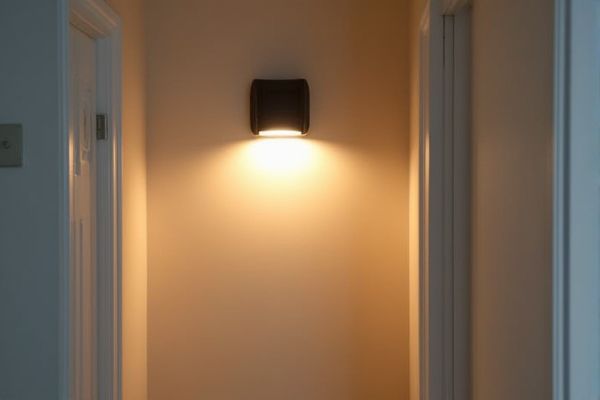
Motion sensor lights in your mudroom automatically activate upon detecting movement, offering convenience and energy efficiency compared to switch-controlled lights that require manual operation. Discover which lighting option best suits your lifestyle and how to maximize your mudroom's functionality by reading the rest of the article.
Table of Comparison
| Feature | Motion Sensor Light | Switch-Controlled Light |
|---|---|---|
| Operation | Automatically turns on/off based on motion detection | Manually controlled via wall switch |
| Energy Efficiency | High - activates only when motion detected | Lower - relies on user to turn off when not in use |
| Convenience | Hands-free, ideal for busy or carrying hands | Requires manual switching |
| Installation | May require sensor wiring or smart setup | Simple switch wiring standard |
| Cost | Higher initial cost due to sensor technology | Lower cost, standard switch price |
| Reliability | Depends on sensor accuracy; possible false triggers | High reliability; user controls on/off |
| Best Use Case | Mudrooms with frequent hands-full entry/exit | Simple control for infrequent use areas |
Overview: Motion Sensor Lights vs Switch-Controlled Lights
Motion sensor lights in a mudroom automatically detect movement to illuminate the space, providing hands-free convenience and energy efficiency by turning off when no motion is detected. Switch-controlled lights require manual operation, offering consistent control but risking energy waste if left on accidentally. Your choice depends on preferences for automation, energy savings, and ease of use in high-traffic areas like mudrooms.
Understanding Lighting Needs in a Mudroom
Motion sensor lights in a mudroom offer automated illumination that activates based on movement, enhancing convenience and energy efficiency by turning off when the space is unoccupied. Switch-controlled lights give you direct control over lighting intensity and timing, allowing for consistent brightness tailored to specific tasks such as organizing shoes or coats. Understanding your mudroom's lighting needs involves considering traffic patterns, natural light availability, and the balance between automation and manual control to optimize both functionality and energy savings.
How Motion Sensor Lights Work
Motion sensor lights in a mudroom use infrared or ultrasonic sensors to detect movement, automatically turning the light on when motion is sensed and off after a preset period of inactivity. These sensors capture changes in heat patterns or sound waves, triggering the lighting without manual intervention. Compared to switch-controlled lights, motion sensor systems enhance energy efficiency and convenience by eliminating the need to manually operate the light switch.
How Switch-Controlled Lights Work
Switch-controlled lights in a mudroom operate through a manual electrical switch that completes or interrupts the circuit, allowing users to turn the light on or off at will. These switches are typically hardwired to the light fixture and require physical interaction, providing direct control over illumination based on the occupant's needs. The system relies on standard wiring and does not detect movement or ambient conditions, making it energy-dependent on user intervention.
Energy Efficiency Comparison
Motion sensor lights in a mudroom significantly reduce energy consumption by automatically turning off when no movement is detected, unlike switch-controlled lights that rely on manual operation and can often remain on unnecessarily. This automation leads to lower electricity bills and a smaller carbon footprint by preventing lights from being left on for extended periods. You can enhance your home's energy efficiency by opting for motion sensor lighting, especially in frequently used transitional spaces like mudrooms.
Installation and Maintenance Requirements
Motion sensor lights in a mudroom require more complex installation involving sensor calibration and power source integration, while switch-controlled lights typically need straightforward wiring and a standard wall switch. Maintenance for motion sensor lights includes periodic sensor cleaning and occasional recalibration to ensure sensitivity, whereas switch-controlled lights involve minimal upkeep limited to bulb replacement and switch inspection. Your choice affects both initial setup time and ongoing attention, with motion sensor systems offering automation at the cost of more detailed upkeep.
Cost Considerations for Both Options
Motion sensor lights typically have higher initial costs due to advanced sensors and installation requirements, but they can reduce energy bills by automatically turning off when not in use. Switch-controlled lights generally cost less upfront and offer straightforward installation, but they may lead to increased electricity expenses if forgotten to turn off. Your choice should balance initial investment with long-term energy savings based on your usage patterns.
Convenience and User Experience
Motion sensor lights in mudrooms enhance convenience by automatically illuminating the space upon entry, eliminating the need to fumble for switches when hands are full. They improve user experience through hands-free operation, promoting safety and accessibility, especially in low-light situations. In contrast, switch-controlled lights offer direct manual control, which some users may prefer for predictable lighting but require deliberate action, potentially compromising ease of use.
Safety and Security Benefits
Motion sensor lights in a mudroom enhance safety by automatically illuminating the area when movement is detected, reducing the risk of trips and falls in dark conditions. Unlike traditional switch-controlled lights, they provide hands-free operation, ensuring your hands are free to carry items without fumbling for a switch. The automatic activation also deters intruders, offering added security by instantly lighting up the space when someone enters.
Which Light is Best for Your Mudroom?
Motion sensor lights offer hands-free convenience and energy efficiency by automatically illuminating your mudroom when movement is detected, ideal for busy or cluttered entryways. Switch-controlled lights provide reliable, manual control and consistent lighting, preferred for precise operation or when sensor malfunctions are a concern. Choosing between them depends on your lifestyle priorities: ease and automation with motion sensors or predictable control with traditional switches.
 homyna.com
homyna.com